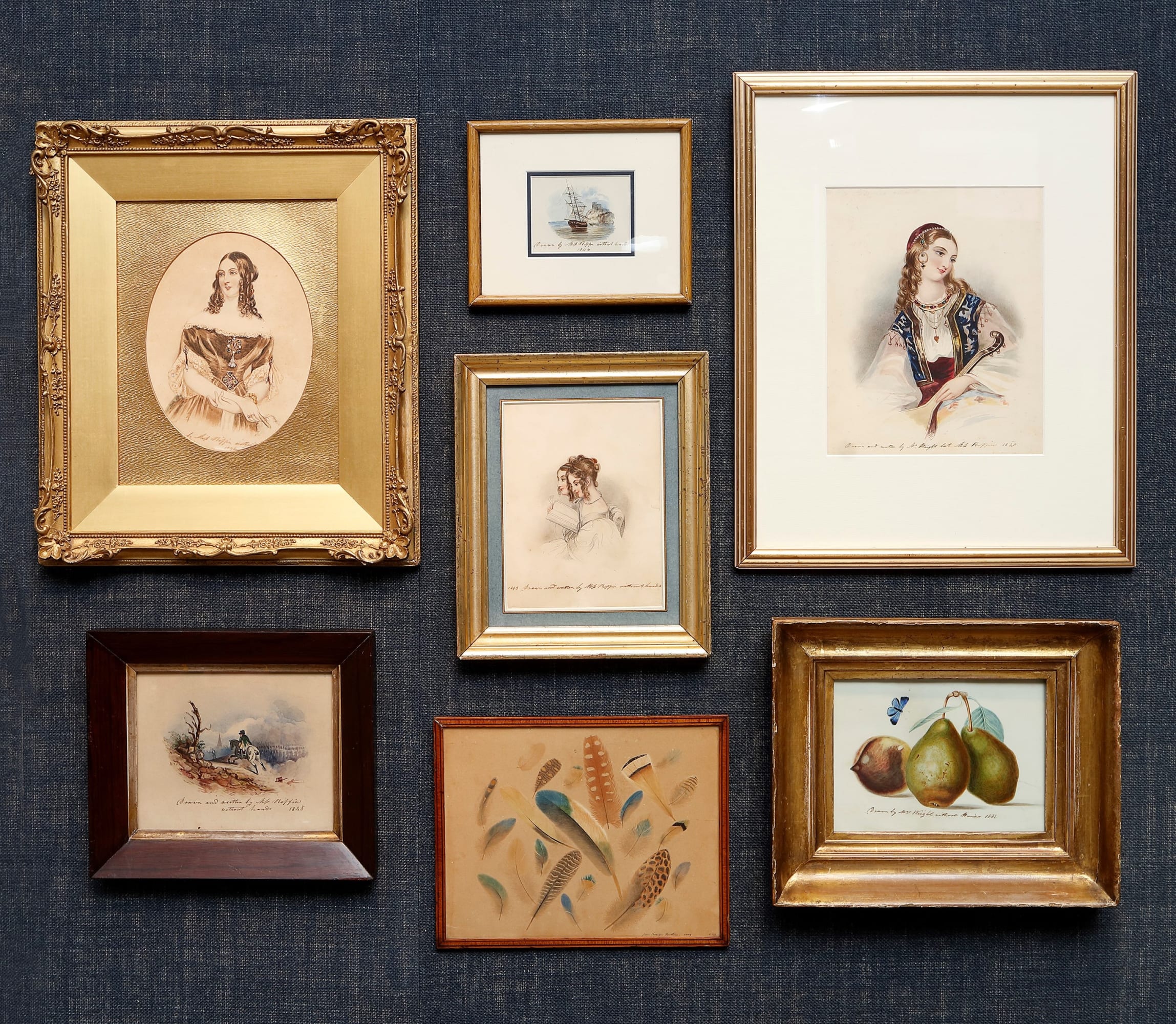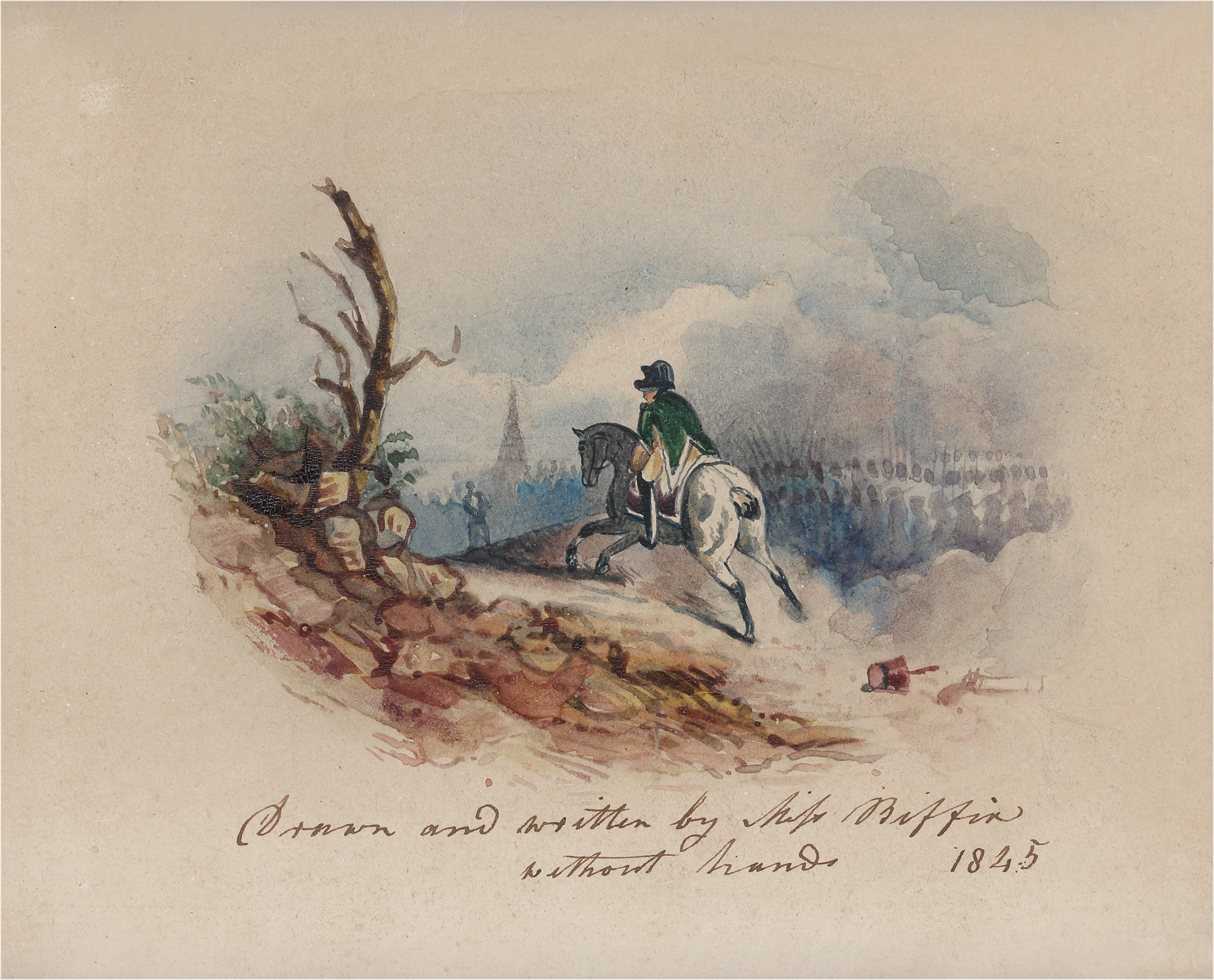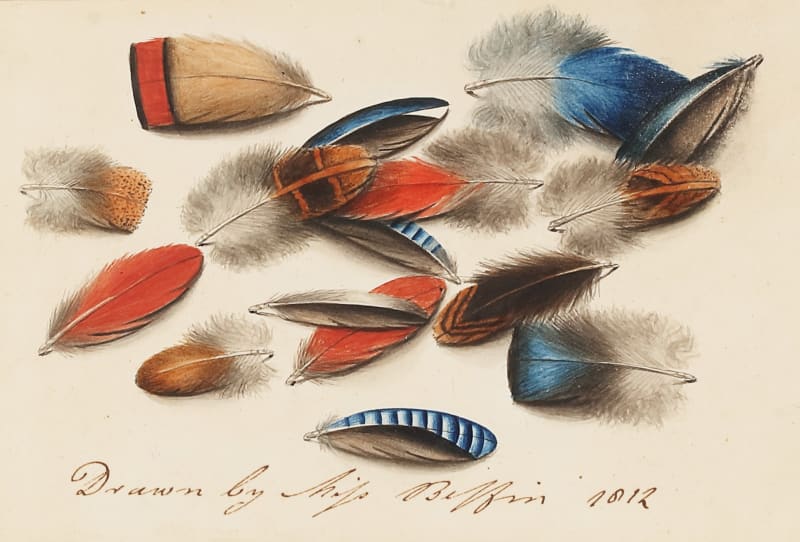Biffin and Waterloo
by Valeria Vallucci
Thirty years after the Battle of Waterloo, Sarah Biffin produced a commemorative watercolour on paper entitled Napoleon at the Battle of Waterloo. Owned by a private collector, it is currently displayed in our solo exhibition ‘Without Hands’: The Art of Sarah Biffin.[1]
The picture shows Napoleon from behind and makes us wonder where he is heading. He looks energetic and balanced, galloping up a small hill on his horse Marengo, but the dead branches of a tree above a heap of rocks seem to usher him towards disaster. To his right, lower down the slope, we see columns of infantry waiting in line. One soldier stands apart waiting for a sign. Clouds and the fog of war are blended in a dramatic blotchy blue-grey sky as if announcing the imminent defeat of one of the greatest leaders in history. Biffin has caught a specific moment of Napoleon’s retreat in the evening of 18th June 1815, a turning point of European history.
The more I study this small work, the more fascinating details I notice. In the far background, is the 35 feet tall observation tower Napoleon had built before the battle.[2] Checking the position of the tower against contemporary maps of Waterloo means we can identify the location with some precision: Napoleon is riding north to re-join Marshal Reille’s II Corps de la Grande Armée. The smoke on the far right is likely to be related to the French recapture of the village of Plancenoit from the Prussians.[3] This means Biffin had a fairly accurate topographical knowledge of the battlefield, either from studying contemporary prints or by exploring Waterloo in person (or both).
Evidence has been found of Biffin spending at least a month in Brussels in 1821.[4] She was advertising an exhibition at the Répositoire des Arts in rue Montagne de la Cour towards the end of October 1821.[5] Though Brussels was an attractive destination for any tourist, Biffin was there exactly at the time when newly crowned George IV was passing through the Netherlands.[6] The king and his dignitaries were coming back from an official visit to Hanover, where a meeting of the allied powers, part of the peaceful negotiations of the aftermath of the Congress of Vienna, took place. The fact that Biffin was working in Brussels at the end of October 1821 when George IV and a high number of Englishmen were in town was no coincidence.
I have started to think of Biffin in the same way I have studied and imagined other early nineteenth-century poets. As a travelling Romantic artist keenly aware of the past, she wanted to be part of history and to record that moment with the travelling court. Obviously, her entrepreneurial spirit was playing a big part too: she saw a chance to secure important commissions.[7] But first and foremost, Biffin was in Brussels the year Napoleon died, when ‘war tourism’ exploded on a massive scale. The fields of Waterloo, only ten miles from Biffin’s exhibition, were an unmissable stop on the Continental tour.
We do not know if Biffin visited the battlefield. As with much of the rest of her trip to what was then part of the United Kingdom of the Netherlands, it remains a mystery that needs to be fully investigated. However, considering that Biffin was a confident traveller, I am inclined to believe she probably did go to Waterloo for a day, and Napoleon at the Battle of Waterloo could be evidence of this.
The watercolour is original in the way it seems to recount an eye-witness account of the enemy’s escape. She may well have heard the story from the many local tourist guides or from veterans. In the foreground, in Napoleon’s wake, is a particularly poignant detail. What looks like a British hussar’s helmet lies beside a severed leg on the country lane. This small detail symbolises the vast number of deaths and injuries suffered by the allied army during the battle. According to the Forces War Records, “of the 68000 Anglo-Allied armed forces, there were 17000 military casualties, 3500 killed outright, 3300 missing and over 10000 wounded”.[8] Amid the carnage, members of the hard-pressed medical service performed a total of 2,000 amputations and “500 Allied limb removals” were carried out on the last day of the battle.[9] Subtly and gracefully, Biffin captures the horror of Waterloo but softens it with a spiralling cloud of dust raised by the hooves of the galloping Marengo.
The abandoned leg in Biffin’s watercolour recalls that of cavalry commander Lord Uxbridge. His leg, buried near the battlefield and marked by a tombstone, became a tourist attraction and was celebrated in Epitaph for the Tombstone Erected over the Marquis of Anglesey’s Leg, Lost at Waterloo (1821) by British politician George Canning.[10] Unsurprisingly, nineteenth century satirical writers drew comparisons between Biffin and Lord Uxbridge (created Marquess of Anglesey after Waterloo). A fictional sarcastic letter from Mrs Ramsbottom to John Bull (1829) empathises with Lord Uxbridge’s state and implies he did not just lose his leg, but his heart and mind too:
Only think, Mr B[ull] of Lord Angleseye coming home […] I am quite sorry to think what a state he must be in. Miss Biffin, or Billy Bowldish, the corpulent gentleman who used to bump himself along the streets in a band box, ain’t nothing to compare with him. His Lordship told the people of Ireland that he had left his heart with them. Fulmer says, before he said that he must have lost his head and I seen one of his legs buried at Waterloo – of course, after that, the only thing left for him was to pack up his trunk, and come home […].[11]
Mrs Ramsbottom’s joke is rather cruel. Despite being a successful miniature painter, Biffin is mentioned purely as a ‘curiosity’ in the sensationalising style of handbills and newspaper advertisements.[12] However, it does show that connections between the wounded heroes of Waterloo and the famous disabled artist were made.
The presence of the severed leg in the foreground of Biffin’s Napoleon picture also suggests it should be seen in the context of a contemporary discourse about wounded war heroes and their new place in society. Throughout England, these injured and troubled men, whatever their rank or status, were encouraged to take inspiration from a resilient and talented high achiever like Biffin.
The British Newspaper Archive reveals that, long after the Napoleonic Wars, Biffin’s story was especially retold at key moments of history. It seems to become particularly popular in the aftermath of war. Despite the archaic disability language, such articles were invariably trying to be inspirational and stressed the benefits of “drawing on hidden resources”.[13] For example, a philosophical article published in 1865, entitled Life-Purpose and Want of Purpose, portrays Miss Biffin as an historical figure of the calibre of Julius Caesar and Alexander the Great – someone well worth emulating. She is held up as an inspiring example of a person of “wondrous will” and “invincible determination”:
The difference between men is not so much in talent as in purpose. It is this difference which leads some to success, which lands others in failure. Luck may have a great deal to do with it, but I think it has very little; at any rate, purpose can, will, and does control luck. We do not make enough of the common examples about us. We talk of big heroes, of Alexanders and Caesars; we debate with Landor and Emerson, in their Florentine villa, whether Alexander was as great as his father Philip, and what would have become of his vast empire had he lived ten years longer; and we forget Miss Biffin. But Miss Biffin is much nearer our time, and a far better instance of invincible determination.[14]
Another article published in the Dundee Evening Telegraph after the First World War stressed Biffin’s “indomitable courage [which] enabled her to triumph over the severest physical disability”.[15] Firstly, the name of Biffin is put to use in an emerging imperial narrative of fortitude and endeavour as Britain rushed to grab new colonies. Subsequently, it is associated to the importance of overcoming physical limitations in the context of the tens of thousands of wounded Great War veterans for whom loss of limbs often led to feelings of lost identity and purpose.
After Waterloo and almost a century of peace and progress, “the First World War put disability on display”[16] as huge numbers of young British men came home damaged. As one author puts it: “with the First World War came that sudden and horrifying increase in the number of limbless soldiers”.[17] This army of severely disabled returnees made a huge psychological impact on the public, and the country was ill-equipped to deal with them. Little appropriate housing or health care was available, “and above all ideas on what to do to help”.[18] It is in this context that Biffin begins to be depicted as an iconic and relevant modern hero.
Napoleon at the Battle of Waterloo may not be one of Biffin’s most iconic works, but it points the way to her later emergence as an icon for wounded veterans of future battles. It shows the sad contrasts of war: the physical agonies endured by the victors and the intense humiliations suffered even by a great, defeated leader. Nobody is a true winner. By choosing to depict Napoleon from behind, in an unedifying position, bent over his horse, Biffin plays with this aspect of conflict. By adding an ‘Allied limb’ in the foreground she encourages her audience to reflect on the ambiguities of war, and on the importance of living fully and fulfilling our purpose despite whatever destiny throws at us.
_________________________________________________
[1] “Without Hands” The Art of Sarah Biffin, edited by Emma Rutherford and Ellie Smith, Philip Mould & Company, 2022, p. 99.
[2] http://www.theobservationpost.com/blog/?p=365
[3] https://www.napoleon-series.org/images/military/maps/1815/waterloo1.jpg; https://www.rijksmuseum.nl/en/collection/RP-P-OB-86.758.
[4] SMITH, E., “Sarah Biffin: Biography”, in “Without Hands” The Art of Sarah Biffin, p. 25.
[5] BL MF 253, Le Courrier des Pay-Bas (6 Aug to 31 Dec 1821), 28 October 1821, p. 4.
[6] From September to November 1821 George IV travelled through the Continent with the Duke of Wellington, Castlereagh, and a group of dignitaries. After stopping at Calais and Lille, George IV reached Brussels and dined at Palais de Laeken (28th Sept). He was invited to go to the theatre by the Belgian king and queen (29th Sept) but did not enjoy the performance. The following day George IV inspected the fields of Waterloo. He then reached his palace in Hanover, where he was welcomed by his brothers, the dukes of Cambridge and Cumberland. George IV travelled back to England through Belgium in ‘strict incognito’ and had a private meeting with the King of Netherlands at the beginning of November.
[7] Biffin was appointed miniature painter to the Prince of Orange at “a party in Brussels”. See Royal Cornwall Gazette, 29 May 1830; The Albion, 14 March 1842.
[8] https://www.forces-war-records.co.uk/men-of-the-battle-of-waterloo
[9] https://the-past.com/feature/the-darker-side-of-victory-wellingtons-medical-service-at-waterloo/
[10] https://en.wikipedia.org/wiki/Lord_Uxbridge%27s_leg#Shrine
[11] The London and Paris Observer, 8 February 1829.
[12] Please see JOSHUA, E., “Sarah Biffin In Context”, in “Without Hands” The Art of Sarah Biffin, pp. 59-70.
[13] Runcorn Guardian, 8 October 1982, p. 5.
[14] Leeds Times, 4 February 1865, p. 6.
[15] Dundee Evening Telegraph, 10 March 1924, p. 6.
[16] ANDERSON, J., War, Disability and Rehabilitation in Britain ‘Soul of a Nation’, Manchester University Press, 2011, p. 64.
[17] RYDE, P., Out on a Limb: A Celebration of the British Limbless Ex-Service Men’s Association Golden Jubilee 1932- 1982, BLESMA, 1982, p. 21.
[18] LEARY, M., Painted With Pride: The Forgotten Story of How One Woman Taught the Broken Men of WWI to Live Again, 2016, p. 20.











